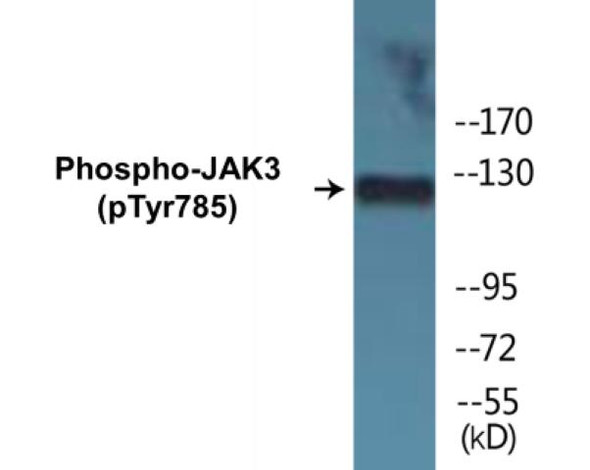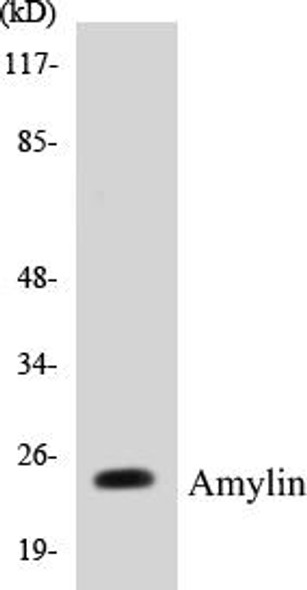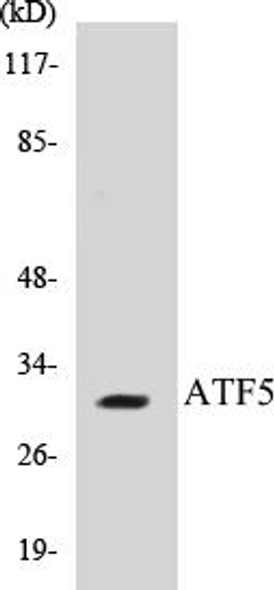Description
JAK3 Colorimetric Cell-Based ELISA Kit
The JAK3 Colorimetric Cell-Based ELISA Kit from Assay Genie is a powerful tool designed for the accurate and reliable detection of JAK3 protein levels in cell cultures. With high sensitivity and specificity, this kit ensures precise results, making it ideal for a variety of research applications.JAK3 (Janus kinase 3) is a key protein involved in the JAK/STAT signaling pathway, playing a crucial role in immune response regulation and cell growth. Dysregulation of JAK3 has been linked to autoimmune diseases, certain cancers, and inflammatory disorders, making it an important target for therapeutic interventions.
With the JAK3 Colorimetric Cell-Based ELISA Kit, researchers can easily measure JAK3 levels in cell culture samples, providing valuable insights into the role of this protein in various physiological and pathological processes. Trust Assay Genie for accurate and dependable results in your research endeavors.
| Product Name: | JAK3 Colorimetric Cell-Based ELISA |
| Product Code: | CBCAB00720 |
| ELISA Type: | Cell-Based |
| Target: | JAK3 |
| Reactivity: | Human, Mouse, Rat |
| Dynamic Range: | > 5000 Cells |
| Detection Method: | Colorimetric 450 nmStorage/Stability:4°C/6 Months |
| Format: | 96-Well Microplate |
The JAK3 Colorimetric Cell-Based ELISA Kit is a convenient, lysate-free, high throughput and sensitive assay kit that can detect JAK3 protein expression profile in cells. The kit can be used for measuring the relative amounts of JAK3 in cultured cells as well as screening for the effects that various treatments, inhibitors (ie siRNA or chemicals), or activators have on JAK3.
Qualitative determination of JAK3 concentration is achieved by an indirect ELISA format. In essence, JAK3 is captured by JAK3-specific primary antibodies while the HRP-conjugated secondary antibodies bind the Fc region of the primary antibody. Through this binding, the HRP enzyme conjugated to the secondary antibody can catalyze a colorimetric reaction upon substrate addition. Due to the qualitative nature of the Cell-Based ELISA, multiple normalization methods are needed:
| 1. | A monoclonal antibody specific for human GAPDH is included to serve as an internal positive control in normalizing the target absorbance values. |
| 2. | Following the colorimetric measurement of HRP activity via substrate addition, the Crystal Violet whole-cell staining method may be used to determine cell density. After staining, the results can be analysed by normalizing the absorbance values to cell amounts, by which the plating difference can be adjusted. |
| Database Information: | Gene ID: 3718, UniProt ID: P52333, OMIM: 600173/600802, Unigene: Hs.515247 |
| Gene Symbol: | JAK3 |
| Sub Type: | None |
| UniProt Protein Function: | JAK3: a non-receptor tyrosine-kinase of the Jak family expressed predominantly in immune cells. Mediates signal transduction via the common gamma-chain of cytokine receptors, including IL-2, -4, -7, -9, and -15. Interacts with members of the STAT (signal transduction and activators of transcription) family. Interacts with STAM2 and SHB. Contains two protein kinase domains. Mutations that abrogate JAK3 function cause an autosomal SCID (severe combined immunodeficiency disease). Inhibitor: R017s for organ transplants. Three differentially spliced isoforms have been described. |
| UniProt Protein Details: | Protein type:EC 2.7.10.2; Protein kinase, tyrosine (non-receptor); Protein kinase, TK; Kinase, protein; TK group; JakA family Chromosomal Location of Human Ortholog: 19p13.1 Cellular Component: cytoskeleton; cytosol; endomembrane system; extrinsic to internal side of plasma membrane Molecular Function:ATP binding; non-membrane spanning protein tyrosine kinase activity; protein binding; protein phosphatase binding; protein-tyrosine kinase activity; Ras guanyl-nucleotide exchange factor activity; receptor binding Biological Process: adaptive immune response; B cell differentiation; cell migration; elevation of cytosolic calcium ion concentration; enzyme linked receptor protein signaling pathway; innate immune response; MAPKKK cascade; negative regulation of dendritic cell cytokine production; negative regulation of FasL biosynthetic process; negative regulation of interleukin-10 production; negative regulation of interleukin-12 production; negative regulation of T cell activation; negative regulation of T-helper 1 cell differentiation; peptidyl-tyrosine phosphorylation; positive regulation of activated T cell proliferation; positive regulation of calcium ion transport; positive regulation of GTPase activity; positive regulation of immune response; positive regulation of T cell proliferation; protein amino acid phosphorylation; STAT protein nuclear translocation; T cell homeostasis; tyrosine phosphorylation of STAT protein; tyrosine phosphorylation of Stat5 protein Disease: Severe Combined Immunodeficiency, Autosomal Recessive, T Cell-negative, B Cell-positive, Nk Cell-negative |
| NCBI Summary: | The protein encoded by this gene is a member of the Janus kinase (JAK) family of tyrosine kinases involved in cytokine receptor-mediated intracellular signal transduction. It is predominantly expressed in immune cells and transduces a signal in response to its activation via tyrosine phosphorylation by interleukin receptors. Mutations in this gene are associated with autosomal SCID (severe combined immunodeficiency disease). [provided by RefSeq, Jul 2008] |
| UniProt Code: | P52333 |
| NCBI GenInfo Identifier: | 50403745 |
| NCBI Gene ID: | 3718 |
| NCBI Accession: | P52333.2 |
| UniProt Secondary Accession: | P52333,Q13259, Q13260, Q13611, Q8N1E8, Q99699, Q9Y6S2 |
| UniProt Related Accession: | P52333 |
| Molecular Weight: | |
| NCBI Full Name: | Tyrosine-protein kinase JAK3 |
| NCBI Synonym Full Names: | Janus kinase 3 |
| NCBI Official Symbol: | JAK3 |
| NCBI Official Synonym Symbols: | JAKL; LJAK; JAK-3; L-JAK; JAK3_HUMAN |
| NCBI Protein Information: | tyrosine-protein kinase JAK3 |
| UniProt Protein Name: | Tyrosine-protein kinase JAK3 |
| UniProt Synonym Protein Names: | Janus kinase 3; JAK-3; Leukocyte janus kinase; L-JAK |
| Protein Family: | Tyrosine-protein kinase |
| UniProt Gene Name: | JAK3 |
| UniProt Entry Name: | JAK3_HUMAN |
| Component | Quantity |
| 96-Well Cell Culture Clear-Bottom Microplate | 2 plates |
| 10X TBS | 24 mL |
| Quenching Buffer | 24 mL |
| Blocking Buffer | 50 mL |
| 15X Wash Buffer | 50 mL |
| Primary Antibody Diluent | 12 mL |
| 100x Anti-Phospho Target Antibody | 60 µL |
| 100x Anti-Target Antibody | 60 µL |
| Anti-GAPDH Antibody | 60 µL |
| HRP-Conjugated Anti-Rabbit IgG Antibody | 12 mL |
| HRP-Conjugated Anti-Mouse IgG Antibody | 12 mL |
| SDS Solution | 12 mL |
| Stop Solution | 24 mL |
| Ready-to-Use Substrate | 12 mL |
| Crystal Violet Solution | 12 mL |
| Adhesive Plate Seals | 2 seals |
The following materials and/or equipment are NOT provided in this kit but are necessary to successfully conduct the experiment:
- Microplate reader able to measure absorbance at 450 nm and/or 595 nm for Crystal Violet Cell Staining (Optional)
- Micropipettes with capability of measuring volumes ranging from 1 µL to 1 ml
- 37% formaldehyde (Sigma Cat# F-8775) or formaldehyde from other sources
- Squirt bottle, manifold dispenser, multichannel pipette reservoir or automated microplate washer
- Graph paper or computer software capable of generating or displaying logarithmic functions
- Absorbent papers or vacuum aspirator
- Test tubes or microfuge tubes capable of storing ≥1 ml
- Poly-L-Lysine (Sigma Cat# P4832 for suspension cells)
- Orbital shaker (optional)
- Deionized or sterile water
*Note: Protocols are specific to each batch/lot. For the correct instructions please follow the protocol included in your kit.
| Step | Procedure |
| 1. | Seed 200 µL of 20,000 adherent cells in culture medium in each well of a 96-well plate. The plates included in the kit are sterile and treated for cell culture. For suspension cells and loosely attached cells, coat the plates with 100 µL of 10 µg/ml Poly-L-Lysine (not included) to each well of a 96-well plate for 30 minutes at 37°C prior to adding cells. |
| 2. | Incubate the cells for overnight at 37°C, 5% CO2. |
| 3. | Treat the cells as desired. |
| 4. | Remove the cell culture medium and rinse with 200 µL of 1x TBS, twice. |
| 5. | Fix the cells by incubating with 100 µL of Fixing Solution for 20 minutes at room temperature. The 4% formaldehyde is used for adherent cells and 8% formaldehyde is used for suspension cells and loosely attached cells. |
| 6. | Remove the Fixing Solution and wash the plate 3 times with 200 µL 1x Wash Buffer for five minutes each time with gentle shaking on the orbital shaker. The plate can be stored at 4°C for a week. |
| 7. | Add 100 µL of Quenching Buffer and incubate for 20 minutes at room temperature. |
| 8. | Wash the plate 3 times with 1x Wash Buffer for 5 minutes each time. |
| 9. | Add 200 µL of Blocking Buffer and incubate for 1 hour at room temperature. |
| 10. | Wash 3 times with 200 µL of 1x Wash Buffer for 5 minutes each time. |
| 11. | Add 50 µL of 1x primary antibodies (Anti-JAK3 Antibody and/or Anti-GAPDH Antibody) to the corresponding wells, cover with Parafilm and incubate for 16 hours (overnight) at 4°C. If the target expression is known to be high, incubate for 2 hours at room temperature. |
| 12. | Wash 3 times with 200 µL of 1x Wash Buffer for 5 minutes each time. |
| 13. | Add 50 µL of 1x secondary antibodies (HRP-Conjugated AntiRabbit IgG Antibody or HRP-Conjugated Anti-Mouse IgG Antibody) to corresponding wells and incubate for 1.5 hours at room temperature. |
| 14. | Wash 3 times with 200 µL of 1x Wash Buffer for 5 minutes each time. |
| 15. | Add 50 µL of Ready-to-Use Substrate to each well and incubate for 30 minutes at room temperature in the dark. |
| 16. | Add 50 µL of Stop Solution to each well and read OD at 450 nm immediately using the microplate reader. |
(Additional Crystal Violet staining may be performed if desired – details of this may be found in the kit technical manual.)






